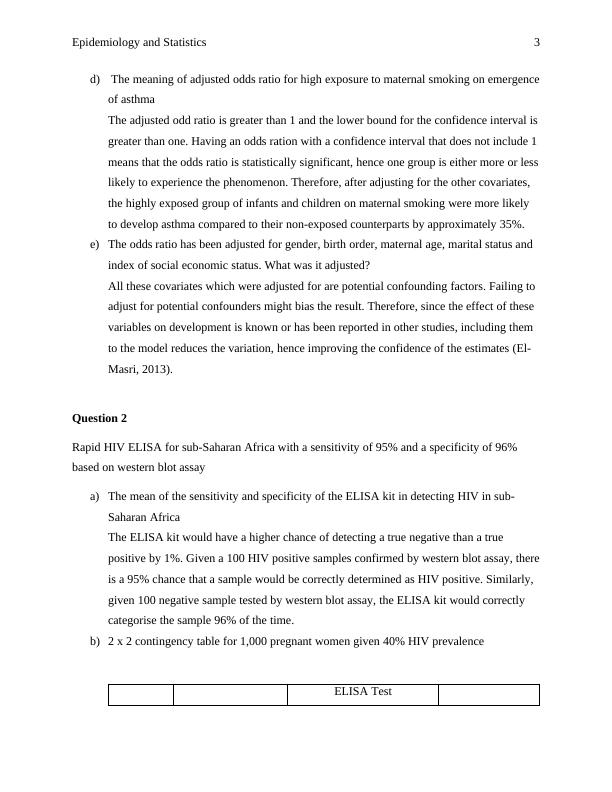Epidemiology and Statistics
Added on 2022-10-16
7 Pages1770 Words117 Views
Epidemiology and Statistics 1
Epidemiology and Statistics
Name
Course Number
Date
Faculty Name
Epidemiology and Statistics
Name
Course Number
Date
Faculty Name

Epidemiology and Statistics 2
Global public Health, Epidemiology and Statistics
Question 1
a) Features of a cohort study with descriptions of how they are applied
i. Study participants are observed over a specified time range, either prospectively or
retrospectively. In this study, singleton births were followed for 7 years while data
was collected using the nationwide registries.
ii. The sample size is determined prior the start of the study. 58 841 was the number of
singleton birth and this number of determined before the study was started. There
were no additional study participants during the study period, which means that the
sample may only decrease because of drop-outs, loss of follow-up among other
reasons.
iii. Study endpoints are clearly stated before commencing the study. In the study, the
researchers clearly defined that an endpoint or observation of interest would be at
least one hospitalisation because of asthma or prescription for asthma before the age
of 7 years. Any observation of interest after the defined time would not be of
importance to the study.
b) Advantages and disadvantages of routinely collected data
Advantages
- Causation can be determined by linking exposure and disease
- Patients data can be independently analysed to understand their progression
Disadvantages
- There is a risk of loss to follow-up which leads to decrease in the study sample size
- Some patients/study participants might miss clinics, hence missing data
c) The risk ratio of high exposures versus no expose
risk ratio=0.045
0.033 =1.364
The relative risk of developing asthma for high exposure to maternal smoking compared
to no exposure was 1.36. Therefore, maternal smoking increased the risk of asthma
among the infants and children by approximately 36%.
Global public Health, Epidemiology and Statistics
Question 1
a) Features of a cohort study with descriptions of how they are applied
i. Study participants are observed over a specified time range, either prospectively or
retrospectively. In this study, singleton births were followed for 7 years while data
was collected using the nationwide registries.
ii. The sample size is determined prior the start of the study. 58 841 was the number of
singleton birth and this number of determined before the study was started. There
were no additional study participants during the study period, which means that the
sample may only decrease because of drop-outs, loss of follow-up among other
reasons.
iii. Study endpoints are clearly stated before commencing the study. In the study, the
researchers clearly defined that an endpoint or observation of interest would be at
least one hospitalisation because of asthma or prescription for asthma before the age
of 7 years. Any observation of interest after the defined time would not be of
importance to the study.
b) Advantages and disadvantages of routinely collected data
Advantages
- Causation can be determined by linking exposure and disease
- Patients data can be independently analysed to understand their progression
Disadvantages
- There is a risk of loss to follow-up which leads to decrease in the study sample size
- Some patients/study participants might miss clinics, hence missing data
c) The risk ratio of high exposures versus no expose
risk ratio=0.045
0.033 =1.364
The relative risk of developing asthma for high exposure to maternal smoking compared
to no exposure was 1.36. Therefore, maternal smoking increased the risk of asthma
among the infants and children by approximately 36%.

Epidemiology and Statistics 3
d) The meaning of adjusted odds ratio for high exposure to maternal smoking on emergence
of asthma
The adjusted odd ratio is greater than 1 and the lower bound for the confidence interval is
greater than one. Having an odds ration with a confidence interval that does not include 1
means that the odds ratio is statistically significant, hence one group is either more or less
likely to experience the phenomenon. Therefore, after adjusting for the other covariates,
the highly exposed group of infants and children on maternal smoking were more likely
to develop asthma compared to their non-exposed counterparts by approximately 35%.
e) The odds ratio has been adjusted for gender, birth order, maternal age, marital status and
index of social economic status. What was it adjusted?
All these covariates which were adjusted for are potential confounding factors. Failing to
adjust for potential confounders might bias the result. Therefore, since the effect of these
variables on development is known or has been reported in other studies, including them
to the model reduces the variation, hence improving the confidence of the estimates (El-
Masri, 2013).
Question 2
Rapid HIV ELISA for sub-Saharan Africa with a sensitivity of 95% and a specificity of 96%
based on western blot assay
a) The mean of the sensitivity and specificity of the ELISA kit in detecting HIV in sub-
Saharan Africa
The ELISA kit would have a higher chance of detecting a true negative than a true
positive by 1%. Given a 100 HIV positive samples confirmed by western blot assay, there
is a 95% chance that a sample would be correctly determined as HIV positive. Similarly,
given 100 negative sample tested by western blot assay, the ELISA kit would correctly
categorise the sample 96% of the time.
b) 2 x 2 contingency table for 1,000 pregnant women given 40% HIV prevalence
ELISA Test
d) The meaning of adjusted odds ratio for high exposure to maternal smoking on emergence
of asthma
The adjusted odd ratio is greater than 1 and the lower bound for the confidence interval is
greater than one. Having an odds ration with a confidence interval that does not include 1
means that the odds ratio is statistically significant, hence one group is either more or less
likely to experience the phenomenon. Therefore, after adjusting for the other covariates,
the highly exposed group of infants and children on maternal smoking were more likely
to develop asthma compared to their non-exposed counterparts by approximately 35%.
e) The odds ratio has been adjusted for gender, birth order, maternal age, marital status and
index of social economic status. What was it adjusted?
All these covariates which were adjusted for are potential confounding factors. Failing to
adjust for potential confounders might bias the result. Therefore, since the effect of these
variables on development is known or has been reported in other studies, including them
to the model reduces the variation, hence improving the confidence of the estimates (El-
Masri, 2013).
Question 2
Rapid HIV ELISA for sub-Saharan Africa with a sensitivity of 95% and a specificity of 96%
based on western blot assay
a) The mean of the sensitivity and specificity of the ELISA kit in detecting HIV in sub-
Saharan Africa
The ELISA kit would have a higher chance of detecting a true negative than a true
positive by 1%. Given a 100 HIV positive samples confirmed by western blot assay, there
is a 95% chance that a sample would be correctly determined as HIV positive. Similarly,
given 100 negative sample tested by western blot assay, the ELISA kit would correctly
categorise the sample 96% of the time.
b) 2 x 2 contingency table for 1,000 pregnant women given 40% HIV prevalence
ELISA Test

End of preview
Want to access all the pages? Upload your documents or become a member.
Related Documents
Statistical Methods in Epidemiology (401176)lg...
|4
|1347
|268
A cross-sectional study design to conduct a multi-level exposure control experimentlg...
|14
|2013
|489
Assignment On Employs A Cross Sectional Study Designlg...
|9
|1878
|24
